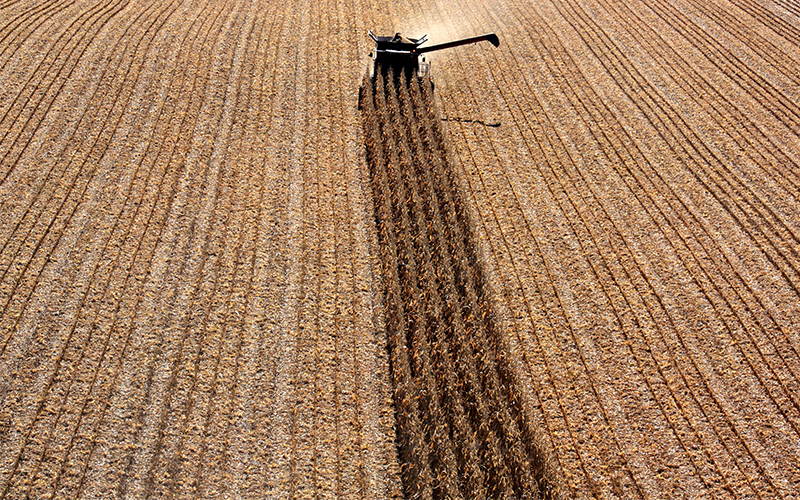May 22, 2020

Beginning on Tuesday, May 26, the USDA Farm Service Agency will begin accepting applications from producers with COVID-related losses for a wide range of commodities. Eligible producers will receive payments based on calculations USDA has made of national losses, multiplied by the individual producer’s documented production or sales. This relief program is funded by the CARES Act and the Commodity Credit Corporation.
Because the funding for these payments is limited, and the exact amount that will be applied for is uncertain, USDA will make an initial payment of 80% of the eligible participants benefit and withhold 20% to a later date. The final payment may be adjusted depending on the amount of aid applied for to match the available funding.
There are a number of commodities eligible for relief payments including:
- Major row crops, such as barley, canola, corn, soybeans, sorghum and wheat
- Wool
- Livestock, such as cattle, hogs and sheep (lambs and yearlings only)
- Dairy - both milk and cull cow sales
- Specialty crops, such as most fruits and vegetables, nuts and mushrooms (although there are limited benefits for some items)
USDA has also issued a Notice of Funding Availability (NOFA) to solicit feedback on making additional crops available for the Coronavirus Food Assistance Program (CFAP) if producers of those commodities believe they have faced a five percent or greater price decline between January and April 2020 – this would include ornamental horticultural products.
Payment Limits
For all commodities, payments under this program are limited to $250,000 per person or legal entity. LLCs, closely-held corporations and limited partnerships may receive up to $250,000 per owner (up to $750,000). If the person’s or legal entity’s average adjusted gross income (AGI) exceeds $900,000, at least 75% of the person’s or legal entity’s income must be derived from farming to be eligible. Additional limitations and restrictions apply.
Scenarios
Dairy
Eligible dairy producers will receive $4.71/cwt of milk production in the first quarter of 2020, and $1.49/cwt of milk production is calculated for the second quarter of 2020. Cull cow sales are included under the livestock category for the first quarter. Producers must provide total sales of eligible livestock, by species and class, between January 15, 2020, to April 15, 2020, of owned inventory as of January 15, 2020, including any offspring from that inventory.
Example 1
A 200-cow farm with 1,200,000 pounds of production in Q1, 2020 = ((12,000 cwt x $4.71) + (12,000 cwt x 1.014 x $1.47)) x 80% = $59,526 net benefit for milk production. This farm also had cull-cow sales and would be eligible for a benefit of $125 per head from that category.
Example 2
800 cows with 5,000,000 pounds of production in Q1, 2020 = ((50,000 cwt x $4.71) + (50,000 cwt x 1.014 x $1.47)) x 80% = $248,023. This farm may also be eligible for a benefit from cull-cow sales, subject to the $250,000 cap.
Example 3
3,000 cows with 19,500,000 pounds of production in Q1, 2020, LLC with 3 materially involved shareholders = ((195,000 cwt x $4.71) + (195,000 cwt x 1.014 x $1.47)) x 80% = $750,000
This farm’s payment will be capped at $250,000 per shareholder.
Row Crops
Producers will be paid based on inventory subject to price risk held as of January 15, 2020. A single payment will be made based on 50% of a producer’s 2019 total production or the 2019 inventory as of January 15, 2020, whichever is smaller, multiplied by 50% and then multiplied by the commodity’s applicable payment rates.
Examples
- Corn: 100,000 bushels of production, with at least 50,000 bushels in storage as of January 15, 2020 = (25,000 x $0.67) = $16,750
- Soybeans: 100,000 bushels of production, with at least 50,000 bushels in storage as of January 15, 2020 = (25,000 x $0.95) = $23,750
Livestock and Wool
A single payment for livestock will be calculated using the sum of the producer’s number of livestock sold between January 15 and April 15, 2020, and the highest inventory number of livestock between April 16 and May 14, 2020, multiplied by the payment rate per head. Dairy cull cow sales are not eligible for payments.
Examples
- Slaughter Cattle: Mature Cattle: 15 head sold between January 15 and April 15, and 25 head at peak between April 16 and May 14. = (40 head x $125) = $5,000
- Sheep: less than 2 years old: 15 head sold between January 15 and April 15, and 25 head at peak between April 16 and May 14 = (40 head x $40) = $1,600
- Hogs: 120 pounds or more: 30 head sold between January 15 and April 15, and 50 head at peak between April 16 and May 14 = (80 head x $35) = $2,800
- Wool: 1,000 pounds in storage (graded, clean basis) as of January 15, 2020 = (1,000 x 50%) x ($1.49) = $745
Specialty Crops
Because the growing season is just getting started, most Northeast producers will not have had eligible losses of specialty crops between January 1 and April 15, 2020. However, there may be some producers who had finished crops in storage who may have eligible losses.
Producers of specialty crops are eligible for CFAP payments in the following three categories:
- Had crops that suffered a five percent-or-greater price decline between mid-January and mid-April as a result of the COVID-19 pandemic
- Had produce shipped but which subsequently spoiled due to loss of marketing channel, for which they did not receive payment
- Had shipments harvested and packed that did not leave the farm or mature crops that remained unharvested (i.e. were plowed under), and that which have not been and will not be sold due to loss of market
For example, producers of apples and potatoes are not eligible for category 1 losses but are eligible for categories 2 and 3.
Examples
- Apple grower had 10,000 pounds of apples shipped but not paid for: (10,000 x $0.21) = $2,100
- Potato grower had 100,000 pounds of potatoes packed for an order, which was canceled and which cannot be resold: (100,000 x $0.05) = $5,000
As with other USDA programs, the Farm Service Agency administers the program and determines the final dispensation of funds. The examples provided above are intended to be illustrative and are no way binding on USDA.
The USDA will be providing a CFAP payment calculator with which producers and growers can estimate payments and pre-populate the application for payment — form AD-3314 — once signup begins. Additional information, including a video preview of the payment calculator, is available at Farmers.gov/cfap.
Sources
USDA, Farmers.gov/cfap
Dairy Markets and Policy (DMAP): USDA’s New Direct Payments Program for Dairy Farmers, Information letter IL 20-02, May 20, 2020.
Agricultural and Food Policy Center Texas A&M: Overview of the Coronavirus Food Assistance Program (CFAP), Research Report 20-02, May 20, 2020.




